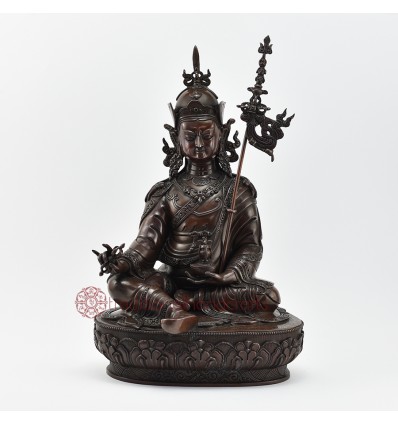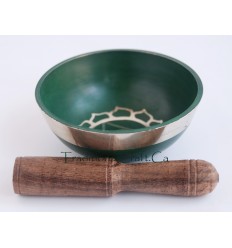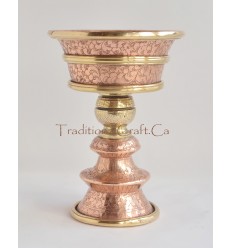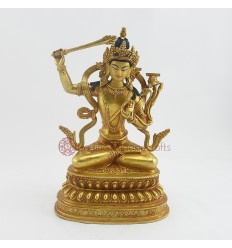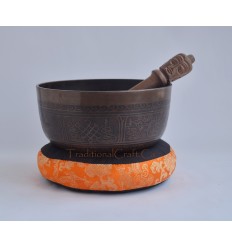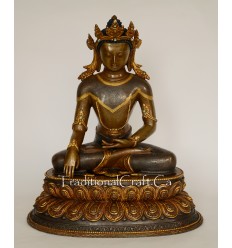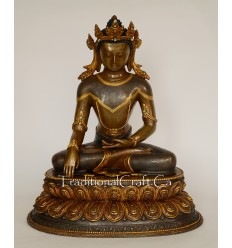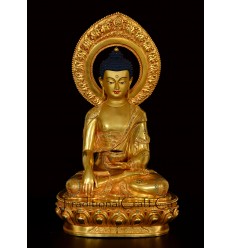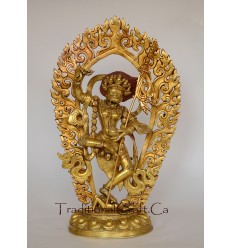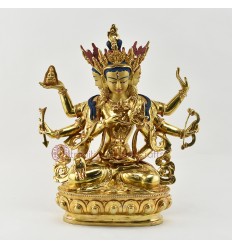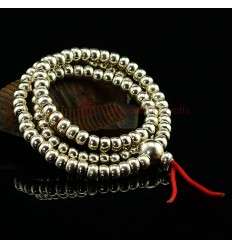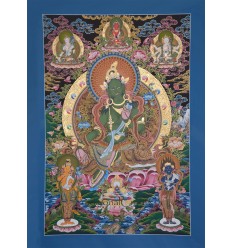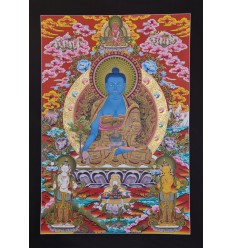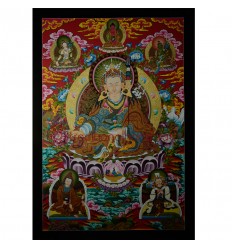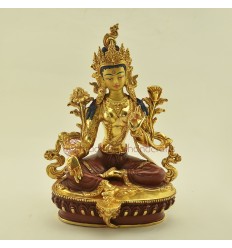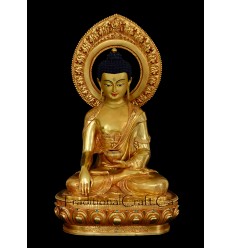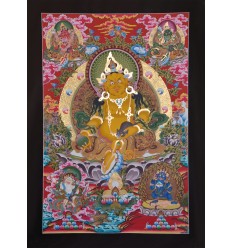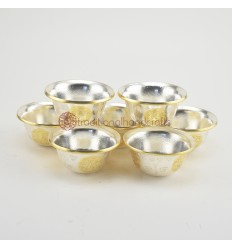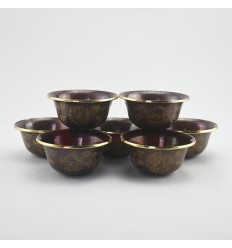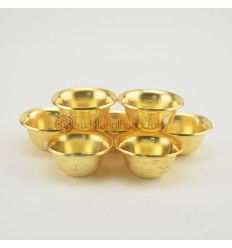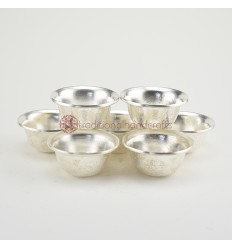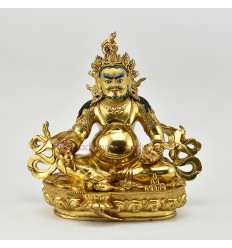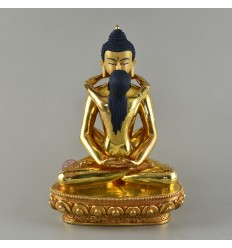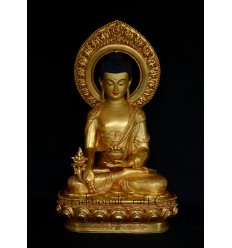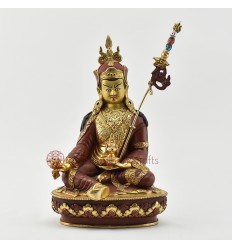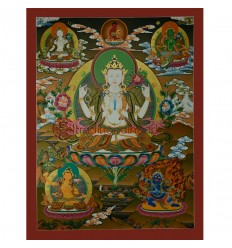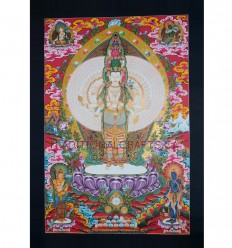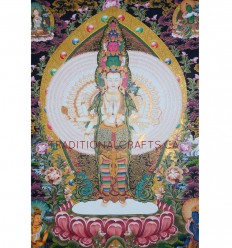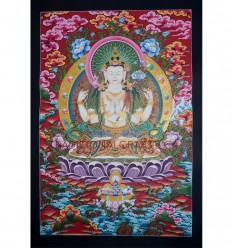No products
Product successfully added to your shopping cart
There are 0 items in your cart. There is 1 item in your cart.
Hand Made Copper Alloy in Oxidation Finish 14.25" Guru Rinpoche Padmasambhava Statue
761768128954
New
Beautifully Fine Quality Hand Carved Tibetan Buddhist Religious Lost Wax Method, Copper Alloy in Oxidation Finish 14.25" Guru Rinpoche Padmasambhava Statue from Patan, Nepal for Shrine / Altar / Monastery
1 Item
Warning: Last items in stock!
Guru Rinpoche / Padmasambhava Statue
|
Name |
Guru Rinpoche / Padmasambhava Statue |
|
Height |
14.25” with Khatvanga |
|
Height |
15” without Khatvanga |
|
Width |
10” |
|
Depth |
7.25” |
|
Material |
Lost Wax Method, Copper Alloy in Oxidation Finish |
|
Actual Weight |
4.564 Kg. |
|
Ships From |
Patan, Nepal |
|
Shipping Provider |
Express Shipping Service |
|
Shipping Time |
Usually ships within 48 hours. Allow 5 – 7 business days for delivery worldwide. |
|
Insurance |
Insurance is included in the shipping cost. |
Guru Rinpoche / Padmasambhava – The Precious Master
Guru Rinpoche, also known as Padmasambhava, is a highly revered figure in Tibetan Buddhism. His name means "Precious Guru," and he is credited with bringing Buddhism to Tibet in the 8th century. Often referred to as the "Second Buddha," Guru Rinpoche is believed to have been instrumental in establishing Buddhism as the dominant religion in Tibet, blending the existing indigenous beliefs with Buddhist teachings.
Early Life and Miraculous Birth
According to legend, Guru Rinpoche was not born in the usual way but miraculously appeared as an eight-year-old child in a lotus flower on Lake Dhanakosha in present-day Afghanistan. This miraculous birth, free from the impurities of the womb, symbolizes his pure and divine nature. He was discovered by King Indrabhuti, who adopted him and raised him as his own son. Unlike the historical Buddha, who attained enlightenment through a gradual process, Guru Rinpoche is said to have been born fully enlightened at the age of eight, declaring his purpose to benefit all sentient beings. His birth was foretold by Buddha Shakyamuni, who predicted that a remarkable being named Padmasambhava would emerge to reveal profound teachings.
Journey to Tibet
Guru Rinpoche's journey to Tibet was marked by a series of miraculous events and teachings. He was invited to Tibet by King Trisong Detsen to help overcome obstacles in building the Samye Monastery, the first Buddhist monastery in Tibet. The king's previous attempts had been thwarted by local spirits and deities, so he sought the help of Guru Rinpoche.
Upon his arrival, Guru Rinpoche subdued the local spirits and deities, converting them into protectors of the Dharma. This act of subjugating the local forces symbolized the integration of Tibet’s pre-Buddhist Bon religion with the new Buddhist teachings. Guru Rinpoche’s mastery of tantric practices enabled him to establish Buddhism firmly in Tibet.
Teachings and Legacy
Guru Rinpoche is especially associated with the Vajrayana or Tantric teachings of Buddhism. He is believed to have transmitted many esoteric teachings and practices, which later became central to Tibetan Buddhism. Among his most important contributions is the introduction of the “terma” tradition—hidden teachings that are meant to be discovered by future generations when the time is ripe. These teachings were concealed in various locations, including caves, rocks, and even in the minds of his disciples, to be revealed by “tertons” (treasure revealers) in later centuries.
One of his primary teachings is the "Eight Manifestations," which represent different aspects of his enlightened activities. These manifestations symbolize his ability to adapt to the needs of various beings, taking on different forms to guide them on the path to enlightenment.
Iconography
In Tibetan art, Guru Rinpoche is often depicted in royal attire, Guru Rinpoche can be seen in his most well-known representation. His eyes are open in a piercing gaze; his face is wrathful and smiling, blazing magnificently with mysterious power. He cradles a Khatvanga in his left arm, representing his consort Mandarava, who arouses the realization of emptiness. His Khatvanga is crowned with three severed heads and a trident, symbolizing Guru Padmasambhava's liberation from the three kayas of desire, form, and formlessness.
He wears a lotus hat ornamented with a sun and moon, representing skillful means and wisdom. His hat also has a Vajra top, symbolizing his unshakable samadhi, and is crowned with a vulture feather, representing his realization of the highest view. In his right hand, he holds a Vajra, an implement used in Tantric rituals to symbolize the union of conventional and ultimate truth. His left hand rests in his lap in the gesture of meditation (Dhyana Mudra) and holds a skull cup containing the nectar vase of immortality. The vase is filled with the nectar of deathless wisdom and is adorned with the leaves of a sacred flowering tree. The vase further serves as a reminder of Guru Padmasambhava's connection to Buddha Amitabha, as it is the special emblem of Amitayus (an aspect of Amitabha). He is usually shown seated on a lotus throne, with a trident staff resting against his shoulder, symbolizing his tantric power and the three kayas (bodies) of Buddhahood.
Besides his popular form, he is also depicted in various forms, including the fierce manifestation known as Guru Dragpo, symbolizing his ability to protect and guide practitioners. His legacy continues through the rituals and prayers performed by his followers, who recite his mantras and celebrate his teachings.
Significance and Contributions to Tibetan Buddhism
Guru Rinpoche is credited with introducing and establishing the Nyingma School of Tibetan Buddhism in the 8th century. He was invited to Tibet by King Trisong Detsen to help overcome various obstacles, including demonic forces that impeded the spread of Buddhism. With his extraordinary powers, he is said to have subdued these forces and laid the groundwork for the construction of Samye Monastery, the first Buddhist Monastery in Tibet.
Guru Rinpoche’s influence on Tibetan Buddhism cannot be overstated. He is revered not only as a historical figure but also as a timeless presence who continues to guide practitioners through his blessings and teachings. His life and deeds are celebrated annually in the festival known as "Guru Rinpoche Day," observed on the 10th day of the lunar month. This day is considered highly auspicious for receiving his blessings.
Guru Rinpoche’s teachings emphasize the importance of direct experience in spiritual practice, the power of devotion, and the integration of wisdom and compassion. His legacy lives on through the numerous texts, rituals, and practices that he introduced, which remain central to Tibetan Buddhism today.
Throughout his life, Guru Rinpoche taught numerous disciples, including the king himself and many other prominent figures, imparting teachings that emphasized the importance of tantric practices and the realization of one’s innate Buddha nature. His teachings were often preserved in the form of terma, or hidden treasures, which would be revealed by future masters known as tertons.
Guru Rinpoche is not only a foundational figure in Tibetan Buddhism but also a symbol of wisdom and compassion, whose teachings continue to inspire countless practitioners across the globe. He is a figure of profound spiritual significance, embodying the fusion of Indian tantric Buddhism and Tibetan spiritual traditions. His teachings continue to inspire and guide practitioners on the path to enlightenment, making him a central figure in the spiritual heritage of Tibet and beyond. His life story, filled with miraculous events and profound teachings, remains a source of spiritual guidance and inspiration for many.
About this Sculpture
This exquisite copper alloy statue is a stunning representation of Guru Rinpoche, also known as Padmasambhava, the revered founder of Tibetan Buddhism. Crafted using the ancient lost wax method, this sculpture is a testament to the exceptional skill and artistry of the Shakya clan of Patan, Nepal, who are renowned for their mastery of sacred metalwork.
The statue has been meticulously hand-carved, showcasing the intricate details and ornate adornments that are characteristic of Tibetan Buddhist art. The fine craftsmanship is evident in every aspect of the piece, from the serene expression on the Guru's face to the delicate patterns adorning his robes and accessories.
The oxidation process has imbued the statue with a rich and sensuous finish, featuring a harmonious blend of black and red hues that enhance the sculpture's visual appeal. The oxidation not only adds depth and character to the piece but also serves to protect the metal from wear and tear over time.
No customer comments for the moment.


